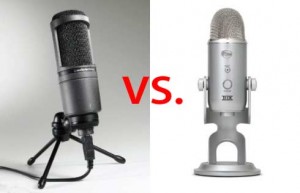 To date Blue’s Yeti hasn’t had much competition in terms of popularity. The Snowball has done well too while other USB mic manufacturers have struggled to keep up with Blue’s success.
To date Blue’s Yeti hasn’t had much competition in terms of popularity. The Snowball has done well too while other USB mic manufacturers have struggled to keep up with Blue’s success.
Audio-Technica, a heavy hitter in the realm of pro studio gear, hasn’t rested on its laurels. The AT2020 is a fine USB mic and one of the bigger threats to the dominance of the Yeti.
Both are great mics but in different ways, which comes down to differing design principles.
The Yeti has physical knobs and buttons both on the front and back, making it ideal for tweakers not big on software controls.
The AT2020 in contrast looks nearly identical to Audio-Technica XLR mics. Hardware controls are absent so gain levels must be adjusted via software.
Most notable strengths of the Yeti are features and value. It handles four polar patterns: cardioid, bidirectional, omnidirectional, and stereo. Many top-end studio mics can’t do all that. No matter the situation, from interviews to instrument recording, to capturing the ambiance of the room, the Yeti is flexible enough to fit the task.
Strengths of the AT2020 are build quality and simplicity (geared towards controlling everything from the computer). While the AT2020 only does a cardioid pattern, this is all most people need anyhow. The build is closer to studio mics rather than USB mics, which tend to have cheap plastic parts. If you’re taking it on the road or recording a variety of characters voices or instruments, the importance of this advantage is boosted. Lastly studio engineers working on location will prefer having all controls at their fingertips and out of the way of the client just as when working with XLR mics.
Moving to sound quality, beyond tech specs there isn’t a world of difference. The AT2020 may have a slight edge overall, but the slight variations in frequency peaks and dips come down to personal preference. On paper the Yeti goes up to 20kHz while the AT2020 maxes out at 16kHz. In practice most adults can’t hear frequencies in that range rendering the difference irrelevant.


Looking at the most noteworthy advantages of each it’s easy to see why the Yeti is chosen more often. It’s more in line with the needs of the self-recording musician or DIY podcaster while the AT2020 is closer to what a pro studio owner would want in a USB mic.
If you’re still on the fence there are full individual reviews of the Blue Yeti and Audio-Technica AT2020 that go into the features and sound quality in greater detail.